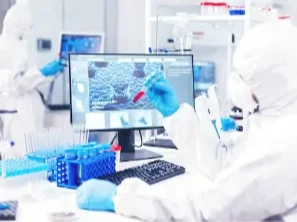The advent of biopharmaceuticals in current medicine brought enormous benefits to the treatment of life-threatening human diseases (e.g., cancer, diabetes and neurodegenerative disorders), and improved the well-being of many people worldwide. The global portfolio of these therapeutic products include proteins and antibodies, nucleic acids, and cell-based products, and continues to expand at a rapid pace - approvals in the period 2015-2018 essentially double the typical five-yearly historical approval pace (G. Walsh, Nat. Biotechnol., 36:1136-1145, 2018) -, representing a significant share of the entire market of pharmaceuticals.
Innovation in the (bio)pharmaceutical industry has been driven towards the development of cost-effective manufacturing processes, envisaging the delivery of products in high quantity, with superior quality (purity), and high specificity, with the ultimate goal of benefiting patients. Progress in this direction have resulted from the application of novel technologies in the upstream stage (high-throughput, single-use devices, statistical optimization of media and fermentation conditions, QbD, and continuous processing), while at the downstream level, chromatography has evolved through the development of new resins and ligands, coupled with advances in process modelling, operating and control strategies.
An emerging trend is the application of alternative solvents such as ionic liquids and deep eutectic solvents, in which their structure and physicochemical properties can be tuned to address unmet needs in (bio)pharmaceutical research. These compounds may be derived from natural and reneawable sources and hold great promise in the development of efficient, sustainable and cost-effective biopharmaceuticals purification processes.
This Entry Collection aims to provide the latest progresses achieved in pharmaceuticals bioprocessing. We welcome submissions of original research, comprehensive reviews and perspectives, including, but not limited, to the following fields:
- Upstream processing (genetic engineering, systems biology, difficult-to-express proteins, expression conditions, Quality by Design approaches, process analytical technologies);
- Chromatographic purification methods (process modelling and control, continuous bioprocessing, design and characterization of resins and ligands, new formats);
- Alternative purification methods (aqueous biphasic systems, filtration, crystallization, precipitation);
- Application of neoteric solvents in upstream and downstream stages;
- Analytical characterization of biopharmaceuticals (stability, post-translational modifications, biological activity, immunogenicity);
- 170
- 09 Sep 2025
- 660
- 24 Jan 2025
- 615
- 24 Jan 2025
- 2.7K
- 04 Sep 2024
- 880
- 26 Aug 2024
- 1.1K
- 31 Oct 2024
- 1.0K
- 26 Jun 2024
- 976
- 26 Jun 2024
- 971
- 29 May 2024

